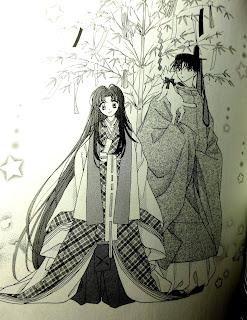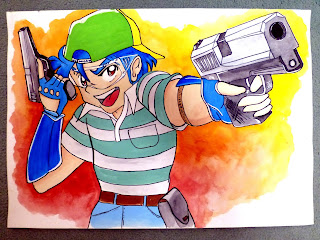Grades 4,5,6
Cartoon
Drawing [MANGA]
Part 1
 |
| Manga [comic books] |
Japanese comic
books, known as MANGA (which are nothing like their American cousins)
are immensely popular with adults as well as kids. They are also
gaining international readers as their popularity spills out beyond
Japan's island borders.
 |
| typical manga bookshelf |
Just about every child (unless he
comes from some other planet) in Japan will have a large collection
of the colorful, seductive comic books. I know this because my own
son had shelves and shelves of them in his room; many of them still
remain and serve as room decoration in what is now my study.
 |
| girls' comics |
Young people in Japan, especially the
girls are not only addicted to reading them, but not a small number
are avid illustrators of their favorite characters as well. I, always
in the market for interesting ideas for art lessons, decided to
capitalize on this ready made enthusiasm for comics, by developing
some lessons built around the world of manga and reversing the drawing process. The cartoon artist draws his or her panels and then reduces
them to fit the story format in the comic book. For this lesson, I
took panels from the comic book and blew them up to normal drawing
size by using a grid ratio (see below) to help students expand the small cartoon
image into a full size drawing.
 |
| popular manga title |
Of course, the stuffier school
authorities frown on students having comic books in school. They are
supposed to be immersed in “serious literature”. But what child
can resist breaking the school rules—that's what they're made for,
after all. So, I, being neither naïve nor stuffy, knew and didn't
particularly care that they all had manga in their school bags. On
the contrary, I depended on it when I started putting manga drawing
lessons into my art curriculum.
 |
| about the right complexity for an average student |
The technique was fairly simple. I
told the kids to bring their manga to class and we would use them to
draw a picture of their favorite characters and/or scenes from the
stories. I had a few sample pictures that I had done previously to
illustrate the technique as I discussed it with them. First I told
them to go through the comic book and look for images that they would
like to draw. I cautioned them to think about the complexity of the
image and choose one that would have a fairly detailed image of a
character and enough background detail so as not to be too busy and
difficult to draw and not too spare as to be too empty [we call it sabishii 'lonely' in Japanese] and/or uninteresting but deceptively "easy" to draw. The kids had to clear the
chosen image with me to ensure that they would be able to handle it.
I even pointedly asked them if they had confidence that they could handle an image I had doubts about. I would then gauge the body language and facial expression of the child's answer. If he/she didn't hesitate I would OK the choice. If not, it was back to the drawing board until they could choose
an acceptable image. After approving their choice I handed them a
large sheet of white drawing paper.
 |
| too simple and uninteresting |
 |
| too complex and detailed for most kids |
I explained and demonstrated the use
of a simple line grid and told them to divide the small image into
quarters with a pencil that could be erased afterward. (Many hated to
deface their beloved manga books.) Next I told them to do the same
thing with the large drawing paper—divide it into quarters. Then it
was a matter of looking carefully at the small image and, using the
guidelines for placement, enlarge the original image onto the large
sheet of paper. The results, of course, depending on the skill of the
individual, were varied, but most were able to reproduce an
acceptable semblance (with allowance for creativity and whimsicality) of the original image. When the drawing was finished and approved by
me, I had the kids trace the entire image in black felt tip marker to
imitate the black line effect of the comic book. That concluded to
first day of this lesson. An extra day could be added if necessary.
 |
| original [top right] and completed drawing showing the guidelines |
 Generally, all black lines including
outlines of the various drawing elements and line elements in the
background design, especially the straight lines frequently used
radiating out to the edges of the paper as in the image on the right
were executed with black felt tip markers.
Generally, all black lines including
outlines of the various drawing elements and line elements in the
background design, especially the straight lines frequently used
radiating out to the edges of the paper as in the image on the right
were executed with black felt tip markers.














